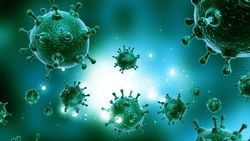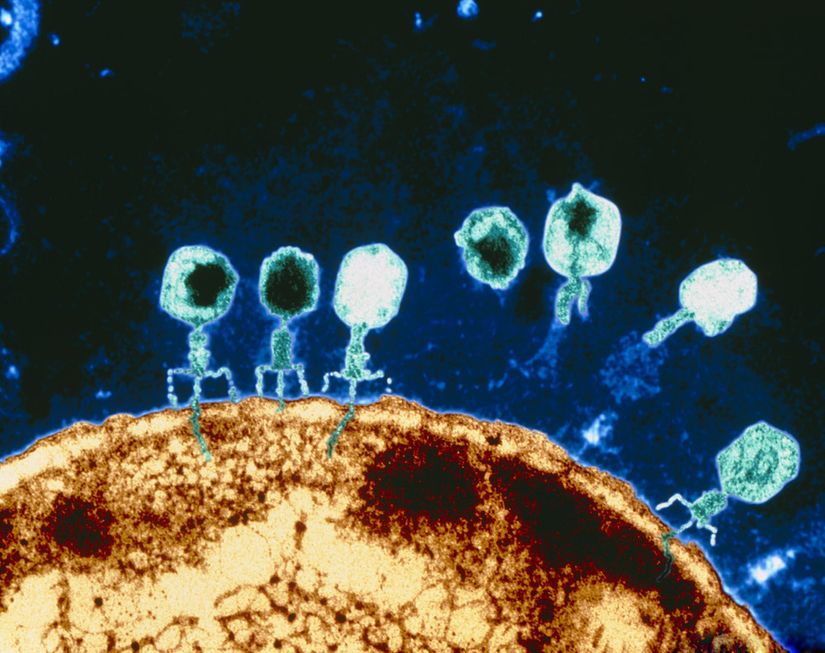What are Viruses? What Makes Them So Powerful?
 Evrim Ağacı
Evrim Ağacı
- Blog Yazısı
Viruses are obligate intracellular parasites. Although it is controversial, the general scientific consensus defines viruses as "beings that are not alive but on the verge of life."
Viruses do not reproduce by mating like we normally see in sexual reproduction, nor by division like we normally see in asexual reproduction. Instead, they use the host cell and its enzymes to reproduce: A virus infects the host cells (such as the cells in the human body) and injects its genome through the membrane of these cells. This genome includes all the information needed to build the parts of a new virus. The virus genome forces the host cell to create these parts and assemble them to create millions and millions of new viruses.
Eventually, in most cases, the sheer number of these viruses are so high that the host cell cannot store any more of them and finally bursts to death. This releases the newly built viruses to the intracellular environment, allowing them to go on to infect new hosts. That is why we started by describing these biological machines as "intracellular parasites", as it is almost never beneficial to the host and in almost all cases, the host cell will be damaged by this process (either by death or sickness, as the number of viruses overwhelm the immune system of the host). Since viruses cannot reproduce without host cells, they are called "obligate" parasites. Note that not all viruses burst their host cells. Sometimes they can use the host as a "virus production factory" that can keep making new viruses; however, in most cases, as the new viruses overwhelm the internal biochemistry of the host cell, this cell will eventually cease to keep up with its own cellular needs, and die.
Adult viruses capable of infecting living cells are called virion. Interestingly, some viruses cannot reproduce on their own, even if they have an available host, due to the mutations they gained in their evolutionary processes. They can only reproduce in the presence of viruses that are evolutionarily close to themselves. These types of viruses are called Defective Viruses. Another type of viruses known as the Satellite Viruses can reproduce in the presence of any other virus.

Virus Features and Composition
Virus morphology (shape) and chemical properties are unique. Viruses cannot be stained with bacteriological dyes and are too small to be seen under a light microscope, making them very difficult to study. Also viruses do not contain cellular organelles, and they are unaffected by antibiotics.
Viruses may contain very few enzymes (proteins). Usually if they do include, these proteins will be special replication enzymes that assist the virus in having a host cell reproduce copies of themselves (e.g. RNA dependent RNA polymerase or reverse transcriptase). Their nucleic acids can be composed of either single or double stranded DNA or single or double stranded RNA. It is important to note that viruses can only have DNA or RNA making up their genetic code, never both. The innermost part of a virus is where the nucleic acid is located and it is surrounded by the capsid (sheath). The capsid is what gives viruses their morphology and protects its nucleic acids.

The advantages of the viral capsid being composed of the same protein subunits are that it requires little genetic information and can self-assemble without the need for any enzymes or energy. This is efficient for a parasite that must hijack host cells to create copies of itself. The capsid may be icosahedral (cubic symmetry) or helical (helical symmetry). However, only in RNA viruses is the capsid helical, as only helical capsids can package RNA. In addition, all viruses with helical symmetry that cause disease in humans contain RNA and are surrounded by a coating that is called the envelope.
The entire nucleic acid and capsid is called the nucleocapsid. All viruses encode their own capsid proteins. The subunits that make up the capsid are called capsomeres, and the subunits that make up the capsomeres, in the form of polypeptide chains, are called protomers. Capsomeres impart important antigenic properties to the virus. These antigenic properties help the virus suppress the immunity system of the host so that the host will not mount an immune response in time to destroy the virus before it has enough time to reproduce. Viruses are usually treated by interferons (proteins synthesized in body cells or medications) that work by inhibiting protein production of the virus by the host. Other methods include injecting antibodies that can counteract the viruses better than the natural immune system of the host.

As you move outward from the nucleocapsid, some viruses have a glycoprotein/lipoprotein membrane or coating called an envelope, as we described above. However, non-enveloped viruses are more insidious and dangerous than enveloped ones, as they can spread much more easily. These types of viruses are more resistant to desiccation (dehydration), gastrointestinal tract digestion processes, antibody defense mechanisms from the host, detergents and other chemicals.
In enveloped viruses, the region between the envelope and the capsid is called the tegument (matrix). In some large viruses, they can store some proteins from the host cell in this region that help inhibit the immune response and facilitate viral replication.

In addition, some viruses have transmembrane glycoproteins on the outside. The virus-specific glycoprotein units in the envelope structure are also called peplomers or colloquially spike proteins. For instance, the main function of the spike proteins outside the SARS-CoV-2 is to adhere onto and infiltrate its genome into the host cell. The below video describes these proteins, as well as the cell infiltration process very clearly.
Aslında maddi destek istememizin nedeni çok basit: Çünkü Evrim Ağacı, bizim tek mesleğimiz, tek gelir kaynağımız. Birçoklarının aksine bizler, sosyal medyada gördüğünüz makale ve videolarımızı hobi olarak, mesleğimizden arta kalan zamanlarda yapmıyoruz. Dolayısıyla bu işi sürdürebilmek için gelir elde etmemiz gerekiyor.
Bunda elbette ki hiçbir sakınca yok; kimin, ne şartlar altında yayın yapmayı seçtiği büyük oranda bir tercih meselesi. Ne var ki biz, eğer ana mesleklerimizi icra edecek olursak (yani kendi mesleğimiz doğrultusunda bir iş sahibi olursak) Evrim Ağacı'na zaman ayıramayacağımızı, ayakta tutamayacağımızı biliyoruz. Çünkü az sonra detaylarını vereceğimiz üzere, Evrim Ağacı sosyal medyada denk geldiğiniz makale ve videolardan çok daha büyük, kapsamlı ve aşırı zaman alan bir bilim platformu projesi. Bu nedenle bizler, meslek olarak Evrim Ağacı'nı seçtik.
Eğer hem Evrim Ağacı'ndan hayatımızı idame ettirecek, mesleklerimizi bırakmayı en azından kısmen meşrulaştıracak ve mantıklı kılacak kadar bir gelir kaynağı elde edemezsek, mecburen Evrim Ağacı'nı bırakıp, kendi mesleklerimize döneceğiz. Ama bunu istemiyoruz ve bu nedenle didiniyoruz.
Other examples of viral infection methods are as follows:
- F protein, a transmembrane glycoprotein on the RSV virion, has hemolytic effects (i.e. allows the virus to break down Red Blood Cells, or erythrocytes) and gives the virus fusion capabilities (i.e. helps the virus bind to the host).
- Neuraminidase breaks down the sialic acid structure of the oligosaccharides that provide protection in cell receptors and allow the virus to infilatrate the host cell.
- On the surface of some viruses, such as the Flu virus (influenza), there is an antibody molecule called hemagglutinin that agglutinate (clump together) erythrocytes. This is an important step in infecting the host and testing for hemagglutinin is a diagnostic tool used in medicine to determine if there is an infection of an enveloped virus.
While the genomes of small viruses consist of only 3-4 genes, this number can reach 200-300 genes in large viruses such as Poxvirus. Except for retroviruses, their genomes are typically all haploid (one strand of DNA/RNA). The structure of the genome can be linear, circular or fragmented/segmental. However, double-stranded DNA viruses can only be in straight or circular forms.
Single or double-stranded DNA/RNA viruses also have a polarity (polarizing electrical charge). The 5'-3' end is called negative polarity, whereas the 3'-5' end is called positive polarity. Positive polarity RNA can use itself as mRNA. However, the RNA polymerase enzyme is absent in a positive polarity RNA and only negative polarity RNA contains the enzyme RNA polymerase. This is because the ribosomes cannot recognize the 3'-5' end of nucleic acids - they can only recognize the 5'-3' end.
- 1
- 1
- 1
- 0
- 0
- 0
- 0
- 0
- 0
- 0
- 0
- 0
- F. J. Fenner. Medical Virology. ISBN: 9780080926568. Yayınevi: Academic Press.
- C. Külah. (Ders Notu, 2019). Bülent Ecevit Üniversitesi Mikrobiyoloji Ders Notları.
Evrim Ağacı'na her ay sadece 1 kahve ısmarlayarak destek olmak ister misiniz?
Şu iki siteden birini kullanarak şimdi destek olabilirsiniz:
kreosus.com/evrimagaci | patreon.com/evrimagaci
Çıktı Bilgisi: Bu sayfa, Evrim Ağacı yazdırma aracı kullanılarak 07/01/2026 08:23:21 tarihinde oluşturulmuştur. Evrim Ağacı'ndaki içeriklerin tamamı, birden fazla editör tarafından, durmaksızın elden geçirilmekte, güncellenmekte ve geliştirilmektedir. Dolayısıyla bu çıktının alındığı tarihten sonra yapılan güncellemeleri görmek ve bu içeriğin en güncel halini okumak için lütfen şu adrese gidiniz: https://evrimagaci.org/s/11398
İçerik Kullanım İzinleri: Evrim Ağacı'ndaki yazılı içerikler orijinallerine hiçbir şekilde dokunulmadığı müddetçe izin alınmaksızın paylaşılabilir, kopyalanabilir, yapıştırılabilir, çoğaltılabilir, basılabilir, dağıtılabilir, yayılabilir, alıntılanabilir. Ancak bu içeriklerin hiçbiri izin alınmaksızın değiştirilemez ve değiştirilmiş halleri Evrim Ağacı'na aitmiş gibi sunulamaz. Benzer şekilde, içeriklerin hiçbiri, söz konusu içeriğin açıkça belirtilmiş yazarlarından ve Evrim Ağacı'ndan başkasına aitmiş gibi sunulamaz. Bu sayfa izin alınmaksızın düzenlenemez, Evrim Ağacı logosu, yazar/editör bilgileri ve içeriğin diğer kısımları izin alınmaksızın değiştirilemez veya kaldırılamaz.









